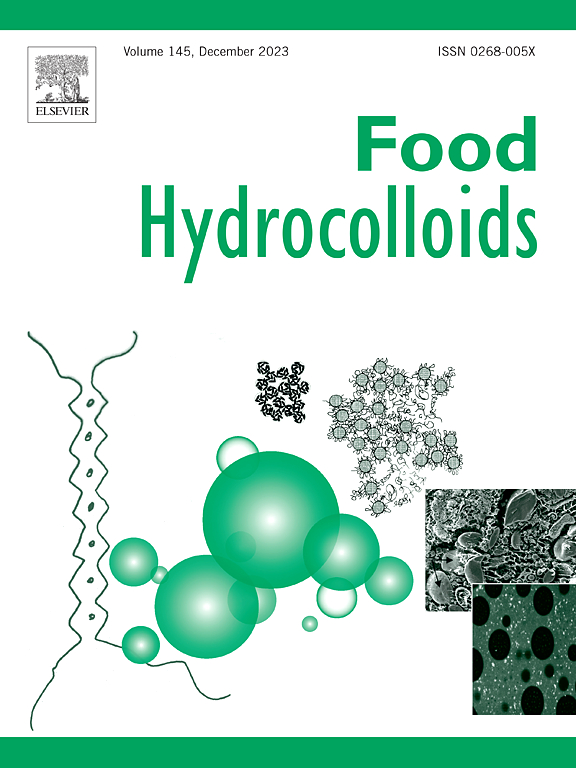Mechanical (ball milling) activation to regulate microstructure of κ-carrageenan and improve freeze-thaw stability of κ-carrageenan gels and κ-carrageenan-based emulsion gels
IF 11
1区 农林科学
Q1 CHEMISTRY, APPLIED
引用次数: 0
Abstract
To expand the wide range of applications of κ-carrageenan in the food and biomedical fields, we have physically modified the carrageenan and focused on its freeze-thaw stability. In this study, κ-carrageenan (KC) was modified by mechanically activated to prepare wet ball milling κ-carrageenan (WMKC), and its properties were determined. The research results indicate that mechanical activation helps improve the freeze-thaw stability of KC gels and enables KC to better maintain its gel network structure during the freeze-thaw process. These phenomena are related to the effects of mechanical activation on the particle morphology, molecular structure, molecular interactions, and moisture migration of κ-carrageenan. The particle morphology images demonstrated that the WMKC particles exhibited a more irregular surface, which facilitated greater penetration of water molecules into the interior of the κ-carrageenan particles. Furthermore, the results of molecular structure and molecular interaction analyses showed that mechanical activation resulted in the removal of sulfate groups from the κ-carrageenan molecular chain. This resulted in more free -OH being exposed on the molecular chain, which in turn provided more binding sites for KC molecules with water molecules. Low-field nuclear magnetic resonance (LF-NMR) results also proved that WMKC could better maintain the binding with water molecules during the freeze-thaw process. A better combination of WMKC molecules and water molecules can significantly diminish the irreversible damage to the gel network structure of WMKC during the freeze-thaw process, thereby effectively enhancing the freeze-thaw stability of WMKC. In addition, we further used WMKC as the gel matrix and investigated that the freeze-thaw stability of the WMKC-based emulsion gel was optimal when the mechanical activation duration was 3h, which well meets the demand of κ-carrageenan emulsion gels in the frozen food industry.
通过机械活化(球磨)调节κ-卡拉胶的微观结构,提高κ-卡拉胶凝胶和基于κ-卡拉胶的乳液凝胶的冻融稳定性
为了扩大κ-卡拉胶在食品和生物医学领域的广泛应用,我们对卡拉胶进行了物理改性,并重点研究了其冻融稳定性。本研究对κ-卡拉胶(KC)进行了机械活化改性,制备了湿法球磨κ-卡拉胶(WMKC),并测定了其性质。研究结果表明,机械活化有助于提高卡拉胶的冻融稳定性,使卡拉胶在冻融过程中更好地保持其凝胶网络结构。这些现象与机械活化对κ-卡拉胶的颗粒形态、分子结构、分子相互作用和水分迁移的影响有关。颗粒形态图像表明,WMKC 颗粒的表面更不规则,这有利于水分子更多地渗入κ-卡拉胶颗粒内部。此外,分子结构和分子相互作用分析结果表明,机械活化导致硫酸基团从κ-卡拉胶分子链中脱落。这导致分子链上暴露出更多的游离 -OH,进而为 KC 分子与水分子提供了更多的结合位点。低场核磁共振(LF-NMR)结果也证明,WMKC 在冻融过程中能更好地保持与水分子的结合。WMKC分子与水分子的更好结合可以显著减少冻融过程中对WMKC凝胶网络结构的不可逆破坏,从而有效提高WMKC的冻融稳定性。此外,我们还进一步使用 WMKC 作为凝胶基质,研究发现当机械活化时间为 3 小时时,基于 WMKC 的乳液凝胶的冻融稳定性最佳,这很好地满足了冷冻食品行业对κ-卡拉胶乳液凝胶的需求。
本文章由计算机程序翻译,如有差异,请以英文原文为准。
求助全文
约1分钟内获得全文
求助全文
来源期刊

Food Hydrocolloids
工程技术-食品科技
CiteScore
19.90
自引率
14.00%
发文量
871
审稿时长
37 days
期刊介绍:
Food Hydrocolloids publishes original and innovative research focused on the characterization, functional properties, and applications of hydrocolloid materials used in food products. These hydrocolloids, defined as polysaccharides and proteins of commercial importance, are added to control aspects such as texture, stability, rheology, and sensory properties. The research's primary emphasis should be on the hydrocolloids themselves, with thorough descriptions of their source, nature, and physicochemical characteristics. Manuscripts are expected to clearly outline specific aims and objectives, include a fundamental discussion of research findings at the molecular level, and address the significance of the results. Studies on hydrocolloids in complex formulations should concentrate on their overall properties and mechanisms of action, while simple formulation development studies may not be considered for publication.
The main areas of interest are:
-Chemical and physicochemical characterisation
Thermal properties including glass transitions and conformational changes-
Rheological properties including viscosity, viscoelastic properties and gelation behaviour-
The influence on organoleptic properties-
Interfacial properties including stabilisation of dispersions, emulsions and foams-
Film forming properties with application to edible films and active packaging-
Encapsulation and controlled release of active compounds-
The influence on health including their role as dietary fibre-
Manipulation of hydrocolloid structure and functionality through chemical, biochemical and physical processes-
New hydrocolloids and hydrocolloid sources of commercial potential.
The Journal also publishes Review articles that provide an overview of the latest developments in topics of specific interest to researchers in this field of activity.
 求助内容:
求助内容: 应助结果提醒方式:
应助结果提醒方式:


